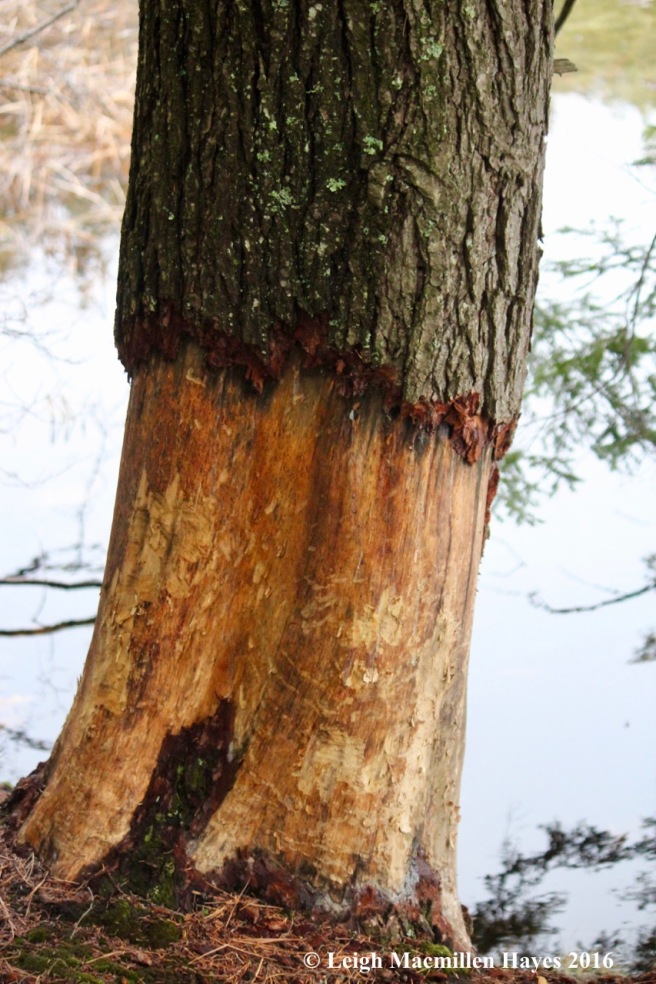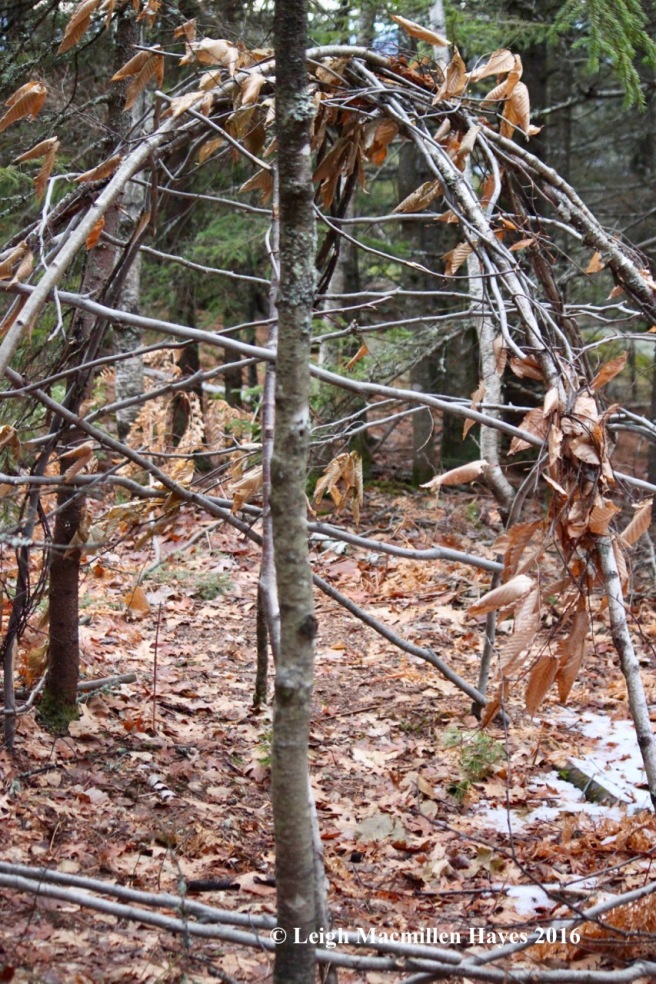Today marks the beginning of the season of hope and with that in mind, my guy and I climbed Singepole Mountain in Paris. Paris, Maine, that is.

Our hike began beside Hall’s Pond, where the water reflected the steel gray sky of this late November day.

And stonewalls and barbed wire reflected the previous use of the land.

In a matter of minutes we learned of its present use.

Everywhere we looked, beaver sculptures decorated the shoreline.

We passed from the hardwood community to a hemlock grove . . .

where more beaver activity was evident. I’ve been reading The Hidden Life of TREES by Peter Wohlleben and have some questions about tree girdling such as this. There is a theory that beavers chew off the bark all the way around (girdle) to eventually kill trees such as hemlock, so preferable species will grow in their place. But, that’s thinking ahead to future generations. Do beavers really do that?

On page 18, Wohlleben states the following: “As the roots starve, they shut down their pumping mechanisms, and because water no longer flows through the trunk up to the crown, the whole tree dries out. However, many of the trees I girdled continued to grow with more or less vigor. I know now that this was only possible with the help of intact neighboring trees. Thanks to the underground network, neighbors took over the disrupted task of provisioning the roots and thus made it possible for their buddies to survive. Some trees even managed to bridge the gap in their bark with new growth, and I’ll admit it: I am always a bit ashamed when I see what I wrought back then. Nevertheless, I have learned from this just how powerful a community of trees can be.”
Could this theory be true? Are the surrounding hemlocks feeding that tree via their roots? If so, does that throw out the other theory? So many questions worth asking.

Soon, we left the Pond Loop Trail and started to climb the Singepole Trail, passing by a gentle giant.

It’s a snag now, but this old maple offered tales of the forest’s past and hope for the future.

On a smaller scale, Downy Rattlesnake Plaintain provided a cheery contrast among the leaf and needle carpet.

The climb was a bit challenging in places, but we held out hope among the ledges that we might see a bobcat.

No such luck, but we did find this . . .

a well used porcupine den.

Water dripped in constant harmony as we stepped gingerly along the narrow ledges and tucked under overhanging rocks.

About halfway up, we took a break and paused to admire the view.

The hardwood and softwood communities became more obvious as we looked down.

And suddenly or so it seemed, my guy reached the moment of truth–the summit.

From the top, we looked around and embraced our home place, which appeared on the horizon in the form of Pleasant Mountain.

A slight turn and the view extended from Pleasant Mountain to the White Mountains.

Below our feet, the granite pegmatite shared its showy display.

We’d read that there was a quarry at the summit, so we headed toward a cairn, in hopes of locating it. Too many jeep trails confused us and we decided to save the quarry for another day. Instead, we turned into the woods to get out of the wind and munch our PB & J sandwiches, the grape jelly courtesy of Marita Wiser and family.

As we poked about, something caught our attention and we moved closer.



A wickiup frame. We admired the efforts of someone to create this traditional structure.

Emerging from the woods, we took one last look at Pleasant Mountain, and . . .

one last view of what seemed to be the summit (though it may have been a false summit).

And then we started down, once again hugging the rocks and trying not to slip.

On the way, I did note a few things, including this fungi that looked more flowerlike than mushroom like.


And I spotted a phenomenon that occurred repeatedly. Girdled beech trees too far uphill for a beaver. What or who had debarked these trees?

I may have been seeing things that weren’t real, but the lines on this particular tree made me wonder about the porcupines. Was I looking at the design they leave with teeth marks created in the distant past? Or were they wounds of another kind?

When at last we reached the Pond Trail again, we continued to circle around it, noting more beaver works.

At last, we found the mud-packed lodge built into the edge of the pond. Here’s hoping for a warm winter within.

Completing the circle, the biting breeze forced us to walk quickly toward our truck and the end of our hike. We have chores to complete tomorrow so our Sundate may have to suffice for a Mondate.
That being said, in this season of hope, we trust we’ll find more opportunities to consider these be-attitudes:

Be supportive of each other.

Be watchful of what’s to come.

Be hopeful of love everlasting.

Bea-you-tiful! We sat on the rocky top of Singepole last summer and watched two eagle circle around the sky above us.
LikeLiked by 1 person
That would indeed BE a sweet treat, Watson. It’s worth more visits. Surprised we had never been there before.
LikeLike
It’s so fun to go with you guys on your dates.
Unusual view of Pleasant Mountain.
The Wohlleben paragraph is interesting, but puzzling. Worth some thought, though. (always the skeptic!).
LikeLiked by 1 person
Always glad to have you along on our dates, JinMe.
And yes, PM from a different vantage point. I love the photo of it behind the spruce trees.
As for the Wohlleben theory–who knows? But it adds one more voice to the conversation. 🙂
LikeLike
I have seen hemlock stumps, cut years ago, that had continued to grow long after the tree was cut. The bark had started to grow over the top of the stump the way it does over a wound on the trunk of the tree. The energy for this could come from nearby hemlock trees feeding the stump’s roots, or perhaps through some sort of parasitic process. I believe the trees root systems sometimes connect.
LikeLike
Thanks for sharing this, Larry. This gives me one more thing to pay attention to and wonder about.
LikeLike